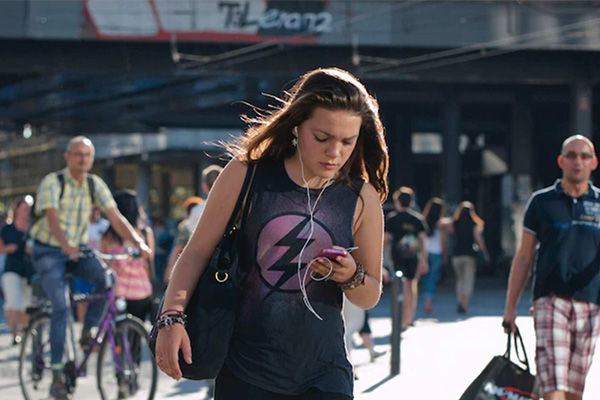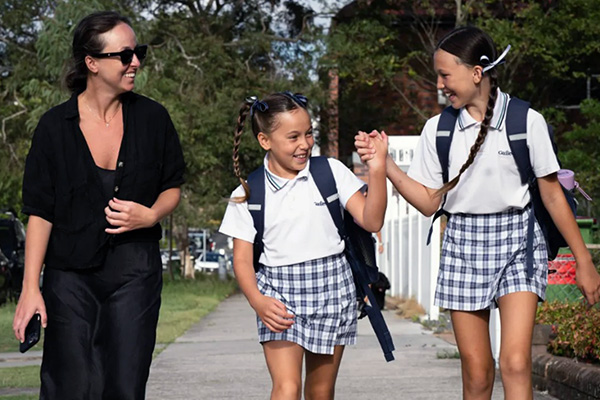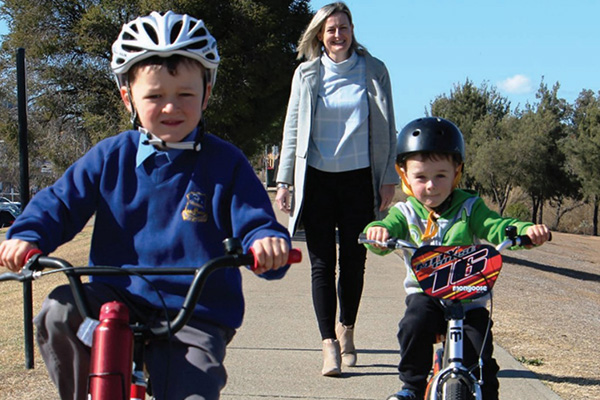Blaming pedestrian behaviour for crashes ignores evidence and decades of bad planning.
When it comes to collisions between vulnerable road users and motor vehicles, Australian traffic laws are fatally flawed. Speed is the culprit, not phone use by pedestrians.
But firstly, to clarify, a vulnerable road user (VRU) is anyone not in a car, bus or truck, but includes pedestrians, motorcycle riders, cyclists, children, the elderly and users of mobility devices. In the event of a crash, VRUs have little to no protection from crash forces. Decades of car-centric planning puts school children, and anyone distracted or vulnerable, at the most risk.
The new normal is no excuse for poor street design and bad driver behaviour. (Photo: ABC)
As a result, children are now more likely to be driven to school than walk, and the odds of being killed in or by a car exceed any other cause. This is also contributing to a public health crisis related to inactivity, as a large percentage of both children (25%) and adults (67%) are now regarded as overweight or obese.
A common source of victim-blaming levelled at pedestrians is mobile phone use
Texting is not a great thing to do when crossing the road. Yet, according to a report from the New York City Department of Transportation, only 2 out of 534 pedestrian deaths between 2014 and 2017 were from distracted texters. The report titled, ‘Distraction Shouldn’t be Deadly’ reiterated the message Bicycle NSW shares with Walk Sydney, 30Please.org and the Better Streets Coalition:
"The best way to address distracted walking, and all forms of distraction, is by creating a road environment focused on speed management ... where vehicles are traveling at a safe speed so that crashes can be avoided. And when crashes do occur they are not fatal or severe," says Bicycle NSW CEO, Peter McLean.
Good leadership needed to keep children safe
Sadly, recent comments by Mosman Cllr Libby Moline show how car-first attitudes are deeply entrenched in our suburbs.
Cllr Moline, quietly reflecting on children in her electorate (Source: Mosman Daily)
Cllr Moline’s recent speech to Mosman Council would have had the famous children's author Roald Dahl clambering for his pen:
“No wonder the cars can’t go anywhere – they’re stopping for these children … who don’t even look up and … acknowledge you when you stop at the pedestrian crossing. I feel like running them over sometimes.” (Source: Mosman Daily)
We are all vulnerable road users most of the time
Whenever we are not encased in metal, we’re significantly more vulnerable to crash forces of speed and mass. The faster, the heavier, the deadlier. To illustrate, in crashes between vehicles and pedestrians: there is a 10% risk that a pedestrian will be killed at 30 km/h, 40% risk at 40 km/h, and 90% at 50 km/h. And this risk is worsened by 8 decades of car-centric planning at the expense of safe pedestrian facilities.
Adding insult to injury
70% of trips under 2km are made by car in Greater Sydney alone. Our communities, our health and the environment are suffering. But perversely, if you get hit by a vehicle, should you survive, it’s all on you. On top of recovering from the terrible injuries, you must also prove that the driver is negligent. Otherwise you’re automatically smashed bodily and financially.
People of all ages and abilities walking and rolling in Erskineville (Friends of Erskineville)
A subtle legal change for safer streets
Our vulnerability to the crash forces involved, is why most European countries now have presumed liability laws. Currently, to claim CTP compensation in NSW, an injured VRU needs to establish that the motorist was negligent. Presumed liability would shift the burden of proof to the motorist to establish that they did not cause the collision. It’s a subtle change. But it places greater emphasis on the motorist to be responsible for their driving
The logic behind presumed liability is very straight forward
The motorist is driving a hard, fast moving object colliding with a person who is soft, slower moving and unprotected. Thus making the VRU more susceptible to injury or death. Intentions are not relevant in such matters. Not unless it can be proven that there was recklessness or criminal intent at play.
Understanding what is needed requires a safe systems approach.
To properly address this issue and realise Australia’s Vision Zero commitment, we must adopt a safe systems approach. Such an approach uses infrastructure and legislation to engineer safety so that momentary lapses of concentration aren’t lethal. For instance, a child breaking free from their caregiver's hand shouldn’t face a death sentence. However, we have grown so accustomed to car-based planning. To illustrate, a recent UK study found that behaviours considered harmful and anti-social are acceptable when applied to cars. Indeed, just last year, more than 1160 Australians were killed on our roads - more than double the national death toll in all the wars since Vietnam!
From this it can be concluded that our streets are dangerous by design and if we want safety, we need to act. (Photo: SMH)
Countries that have adopted a safe systems approach have dramatically safer streets
Oslo, Norway achieved zero cyclist and pedestrian fatalities in 2019 by designing safer streets for all. Safe systems underscore the basic civilising principle to protect our most vulnerable - children, elderly, all of us. This is why Bicycle NSW is campaigning to reduce traffic speeds in urban areas. We’re also advocating hard for safer, more beautiful environments for walking and cycling.
What can you do?
- Get active and join our campaign for Better Streets for better, safer, more beautiful streets for everybody.
- Join the Bicycle NSW family.
- Donate to the Environmental Trust which funds our advocacy campaigns for safer infrastructure and a healthier environment.
Active travel to school Tamworth-style






